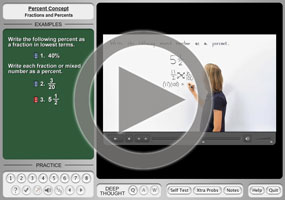Converting Between Decimals, Fractions, and Percents
Percent to DecimalPercent to FractionDecimal to FractionDecimal to PercentFraction to DecimalEquivalents
Purplemath
How do you convert fractions to percents?
To convert a fraction into a percent, start by doing the long division indicated by the fraction. Then you move the decimal point two places to the right and slap on a % sign, and you're done.
(There is a way to convert fractions whose long division does not end nicely, or at least not as quickly as you'd prefer. More on this later.)
Content Continues Below
For example:
First, I did the division to convert the fraction to a decimal. Then I moved the decimal point two places to the right, and slapped on a % symbol.
This started with an improper fraction (that is, the numerator was bigger than the denominator), so I was expecting an answer that was bigger than 100%.
The long division gave me a decimal with three decimal places. This meant that, even after moving the dot, my percentage would have a decimal place. This is perfectly okay. Percentages do not have to be whole numbers.
You can use the Mathway widget below to practice converting fractions into percentages. Try the entered exercise, or type in your own exercise. Then click the button and select "Convert to a Percentage" from the pop-up box to compare your answer to Mathway's. (Or skip the widget and continue with the lesson.)
Please accept "preferences" cookies in order to enable this widget.
(Clicking on "Tap to view steps" on the widget's answer screen will take you to the Mathway site for a paid upgrade.)
However, sometimes the decimal expansion doesn't end; that is, your long division will never be done. This is where the percentage can come in a couple different formats. You can either round the answer, or else you can use a fraction inside the percentage. For instance:
You could round this to, say, 0.389 = 38.9%. But if you aren't supposed to round, then you'll need to pull out a sheet of paper and do the long division. You'll need to get TWO decimal places of answer across the top, and then look at the remainder at the bottom. For this fraction, the long division looks like this:
Fractions are division, so I took the 7 and divided it by the 18. I kept going until I had TWO decimal places (the ".38") across the top. At that point, the remainder was 16.
If you think back to elementary school, you'll recall that you handle remainders by putting them over the divisor (18, in this case), and tacking the resulting fraction onto whatever is the number across the top. In this case, my fraction is , so I get:
So , expressed as an *unrounded* (that is, an exact) percentage, is .
Steps for converting fractions to percents with fractions
- Fractions are division, so do the fraction's long division, to two decimal places.
- Create a fraction by putting the remainder (being the number at the bottom of the long division) over the quotient (being what you'd divided by); tack this fraction onto the two-decimal-place number across the top of the long division.
- Move the decimal point two places to the right (or just erase it), and tack on the percent sign.
This format in a percentage probably looks a little weird to you, so let's do a couple more examples. (If you go into business math, you are going to see a lot of this format.)
Content Continues Below
Other than having memorized the fact, how are you supposed to know that 0.333333... equals ? Here's how:
You may know, just from experience, that one-third, as a percent, is 33 1/3 %. But how do I *show* this? I'll need to do the long-division process:
Note that the remainder is 1 and the divisor is 3, so I'll be tacking a on to the 0.33 from across the top of the division:
To get my answer in percent form, I moved the decimal point two places to the right, tacked on the fractional part, and added the "%" sign.
Here's a messier example that you won't have memorized:
This decimal expansion doesn't end, so I'll do the long division by hand:

Note that the remainder is 10 and the divisor is 35, so I'll be tacking a on to the 0.54 from the top:
All of these "convert a fraction to a percent with a fraction" conversions work the same way: I put the remainder over the divisor, and simplified the resulting fraction; then I moved the decimal point two places to the right, tacked on the (reduced) fraction, and added the % symbol.
URL: https://www.purplemath.com/modules/percents3.htm
Select a Course Below
Standardized Test Prep
Homeschool Math
© 2024 Purplemath, Inc. All right reserved. Web Design by ![]()



